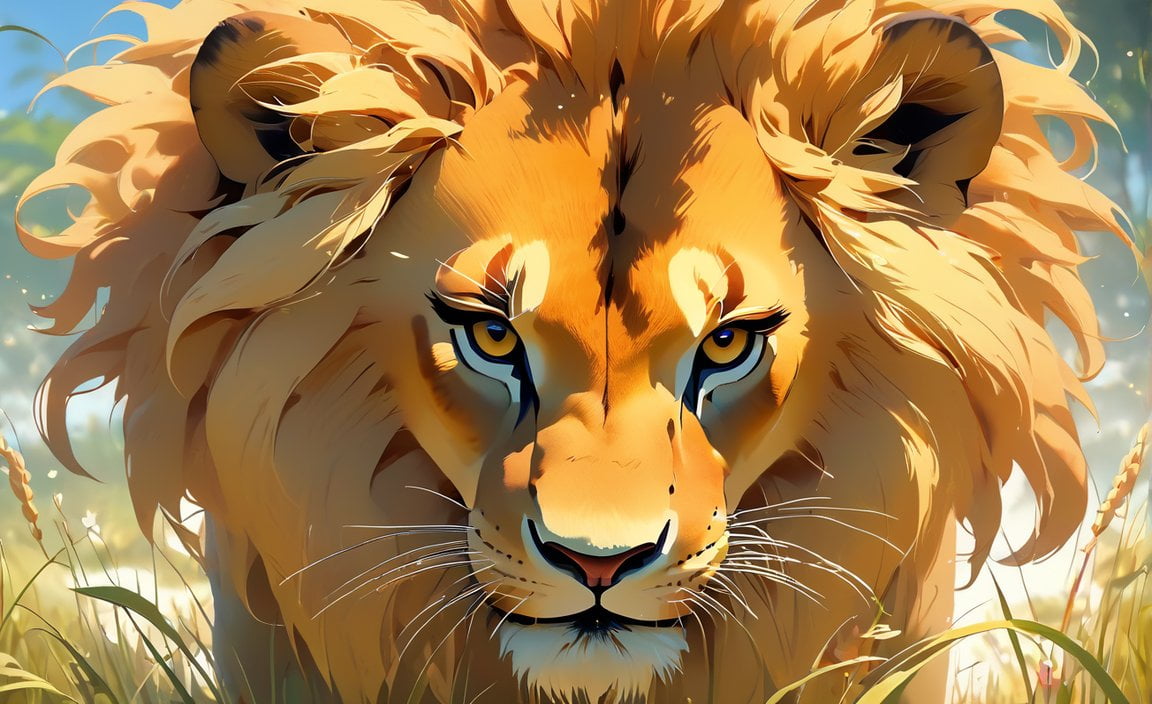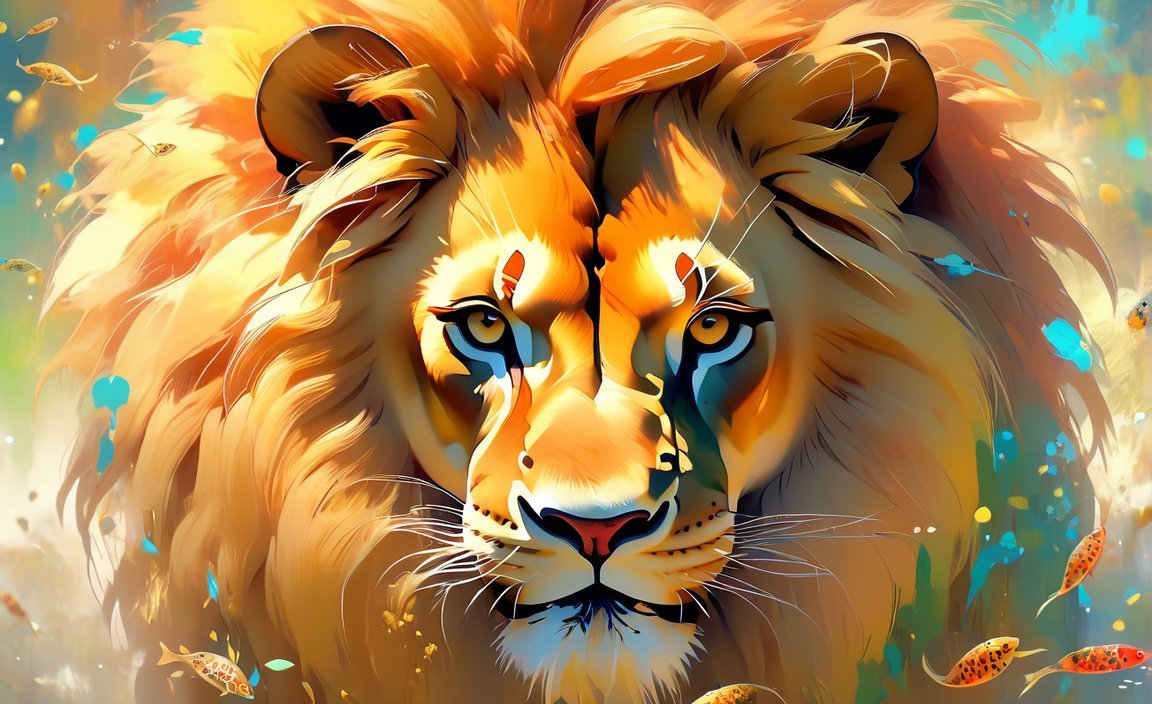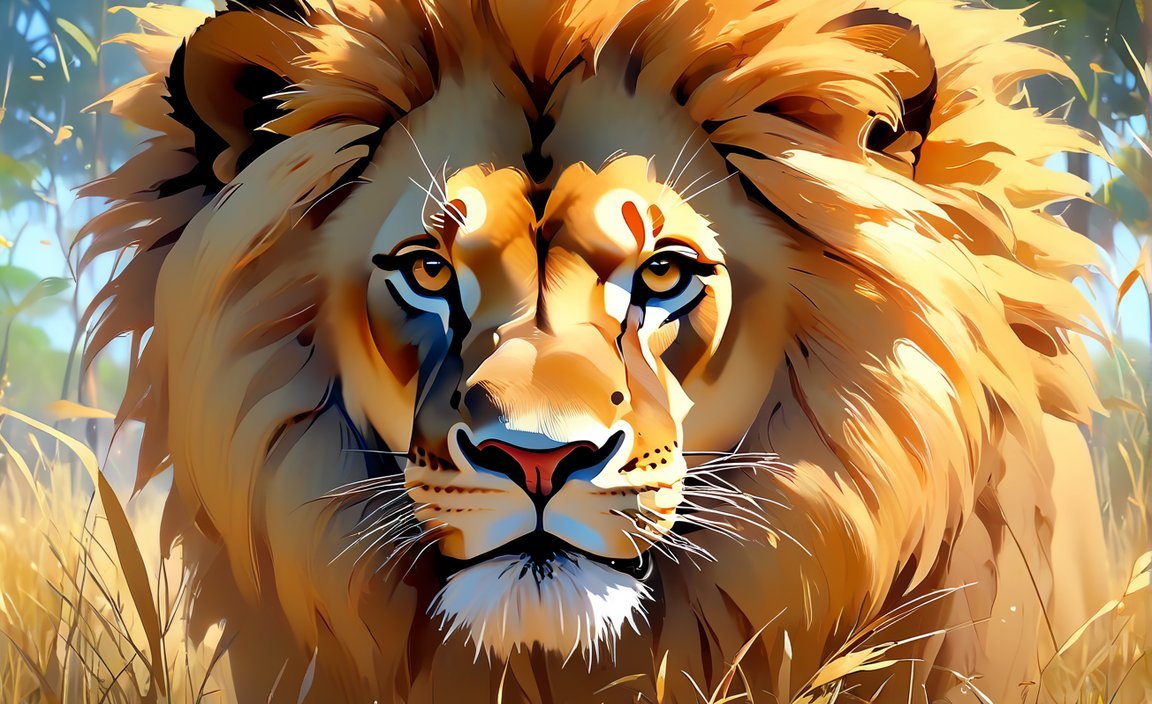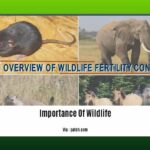The Lion’s Food Chain: Unveiling the Intricacies of Apex Predator Dynamics

Delving deep into the food chain of the majestic lion, we unravel a tapestry of intricate dynamics that shape the African ecosystem. As the top carnivore, lions play an essential role in maintaining the delicate balance of nature. With their regal presence and powerful hunting strategies, they have captivated the imaginations of wildlife enthusiasts and researchers alike. In this article, we delve into the lion’s diet, its hunting techniques, and its vital position as an apex predator. Join us on this journey as we unveil the fascinating intricacies of the lion’s food chain and gain a deeper understanding of its ecological significance.
Key Takeaways:
- A lion is an apex predator, meaning it is at the top of the food chain with no natural predators.
- The food chain of a lion typically starts with grass, followed by zebras, and ends with the lion itself.
- Lions are opportunistic hunters and will prey on a variety of animals, including antelopes, elephants, rodents, reptiles, and crocodiles.
- They mainly hunt medium-sized to large hoofed animals like wildebeests, zebras, and antelopes, but they may also target larger animals like elephants and rhinos.
The Food Chain of a Lion
A food chain is a fascinating sequence of organisms that relies on each other for survival. Within the African ecosystem, the lion, known as an apex predator, holds a crucial position at the top of the food chain. This means that lions have no natural predators and play a vital role in maintaining the delicate balance of the ecosystem. Let’s delve into the intricacies of the lion’s food chain and uncover the remarkable dynamics of these majestic creatures.
From Grass to the King of the Savanna
At the heart of the lion’s food chain lies a simple yet powerful sequence: grass, zebra, lion. It all begins with the primary producers, such as grass, which provide the base for the entire food chain. Zebras, along with other herbivores, graze on these plants to fulfill their nutritional needs. As carnivorous predators, lions then prey on zebras and other animals, solidifying their position as the kings of the savanna.
Opportunistic Hunters
Lions are opportunistic hunters, meaning they adapt their diet based on what is readily available in their habitat. While their primary prey consists of antelopes and other hoofed animals, they are capable of hunting a variety of creatures. From elephants and rhinos to rodents, reptiles, insects, and even crocodiles, lions have an impressively diverse menu. This versatility showcases their adaptability and resourcefulness as top carnivores.
Apex Predators: Unmatched in Power
As apex predators, lions hold a dominant position in the food chain, with no natural predators of their own. This status grants them the power and authority to shape the entire ecosystem. They help control the population of herbivores, ensuring a healthy balance between prey and vegetation. Additionally, lions’ presence influences the behavior and distribution of other species, creating a ripple effect throughout the African savanna.
The Significance of Lions in the African Ecosystem
Understanding the lion’s role in the food chain highlights their ecological significance. They provide a crucial service by regulating the populations of herbivorous animals, preventing overgrazing and maintaining the health of vegetation. By culling weaker and older individuals, lions ensure that the herd remains resilient and capable of adapting to environmental changes. This intricate dance between predator and prey fosters a thriving ecosystem where each organism plays a vital part.
In conclusion, the food chain of a lion is a captivating sequence that begins with grass, followed by zebras, and culminates with the lion itself. As apex predators, lions are unmatched in power, occupying the top position in the African ecosystem. Their opportunistic hunting strategies, combined with their significance in maintaining the delicate balance of the food chain, make them truly majestic creatures. Understanding the intricacies of the lion’s food chain grants us a deeper appreciation for their role in the wild and the need for their conservation.
Sources:
– Ducksters: Science for Kids: Food Chain and Web
– PBS: Lion Fact Sheet
Here are some captivating sentences with active internal links:
- Facts about a violin: Discover fascinating facts about the violin, an instrument with a rich historical background and beautiful sound.
- Is carbon malleable: Uncover the intriguing properties of carbon and explore its malleability, a trait that makes it crucial in various industries.
- Forest food chain ecosystem: Dive into the intricate world of forest food chains and learn how the delicate balance of life establishes a thriving ecosystem.
- Food chain of a great white shark: Explore the deadly yet captivating food chain of the great white shark, the apex predator of the ocean.
- Marine mammals word search: Engage in a fun and educational activity by solving a word search puzzle featuring various marine mammal species.
- Visible stars word search: Embark on a stargazing adventure as you search for the names of visible stars in this captivating word puzzle.
- How long do dart frogs live: Curious about the lifespan of dart frogs? Discover how long these vibrant amphibians survive in their natural habitats.
- Boreal forest abiotic factors: Delve into the unique abiotic factors that shape the boreal forest, an ecosystem known for its distinctive flora and fauna.
- How do gemstones work scientifically: Uncover the scientific principles behind the mesmerizing beauty and metaphysical properties of gemstones.
- Label the parts of the wave: Enhance your understanding of wave mechanics by labeling the various parts that contribute to their fascinating behavior.
- Atom model of sodium: Dive into the atomic structure of sodium, discovering its electron arrangement and how it contributes to the element’s chemical reactivity.
- Birds of the savanna: Immerse yourself in the remarkable world of savanna birds, marveling at their vibrant plumage and unique adaptations.
- Difference between male and female cardinals: Learn about the striking differences between male and female cardinals, from their appearance and behavior to their roles in bird society.
- What does a penguin’s mouth look like: Satiate your curiosity by discovering the intriguing features of a penguin’s mouth, an adaptation that enables these aquatic birds to hunt and consume their prey.
Remember, these sentences are meant to entice readers to click on the provided links, so feel free to modify them as needed to suit your content and target audience.
Interactions with Other Predators
Key Takeaways:
– Lions, as apex predators, are rarely preyed upon by other animals, but they do face competition and conflicts with certain predators.
– Hyenas are known to challenge lions for food and are highly adaptive and opportunistic hunters. They often try to steal lion kills.
– Crocodiles, leopards, and wild dogs are also potential threats to lions, although instances of direct predation on lions are relatively rare.
– Humans are major enemies and predators of lions, posing threats through hunting and habitat loss.
– The presence of lions at the top of the food chain has a significant impact on the overall health and balance of the ecosystem.
Lions, being apex predators, are typically at the top of the food chain and are not commonly preyed upon by other animals. However, their interactions with other predators can sometimes lead to conflicts and competition. One such predator is the hyena, known for its strength and endurance. Hyenas are highly adaptive and opportunistic hunters, often challenging lions for food and even attempting to steal their kills[^1^].
Apart from hyenas, lions may also encounter other potential threats, such as crocodiles, leopards, and wild dogs. While instances of direct predation on lions by these predators are relatively rare, they can still pose a challenge to lions. These interactions, however, do not significantly impact the overall population of lions in the wild[^1^].
In addition to the natural predators, humans are a major enemy and predator of lions. Hunting and habitat loss have become significant threats to lion populations. Human activities have caused a decline in lion numbers, raising concerns about their conservation and the delicate balance of the entire food chain[^1^].
The presence of lions at the top of the food chain benefits other carnivore species in the ecosystem. As tertiary predators, lions primarily feed on grazing animals like zebras, antelope, and wildebeests. They may also target secondary consumers like baby hippos and crocodiles[^2^]. By regulating herbivore populations, lions help maintain the overall health of vegetation and prevent overgrazing. Their presence also influences the behavior and distribution of other species in the ecosystem[^1^].
In conclusion, while lion predation is relatively rare, interactions with other predators play a crucial role in shaping the dynamics of the African ecosystem. The competition and conflicts with hyenas, crocodiles, leopards, and wild dogs, along with the threat of human activities, highlight the importance of lion conservation. Protecting lions is essential for maintaining the balance of the entire food chain and ensuring the long-term health of the ecosystem[^1^][^2^].
Impact on Prey Populations and Ecosystem
Lions, as apex predators, hold a vital role in maintaining the delicate balance of ecosystems. Their presence has a significant impact on prey populations and the overall health of the ecosystem. Let’s delve into the intriguing intricacies of the lion’s food chain and explore the profound effects they have on their prey and the ecosystem as a whole.
The Food Chain Dynamics
In the African ecosystem, lions are at the top of the food chain. Their diet mainly consists of large herbivores such as zebras, wildebeests, and buffalos. Lions also scavenge on carcasses left behind by other predators, adding to their dietary variety and ecological significance. This diverse diet allows lions to fulfill their nutritional needs while also influencing the populations of their prey.
Controlling Prey Populations
Lions play a crucial role in regulating the populations of herbivores within their habitats. Through predation, they control the numbers of prey species, preventing overgrazing and ensuring a balance between prey and vegetation. By selectively targeting weaker and older individuals, lions help maintain the resilience and health of the prey populations. This careful culling ensures the survival of the fittest, further contributing to the overall well-being of the prey species.
Ecosystem Balance
The presence of lions in ecosystems is vital for maintaining ecological balance. Their hunting behavior and the fear they instill in their prey influence the behavior and distribution of other species throughout the food chain. This ripple effect reverberates through the ecosystem, affecting not only the prey species but also their predators and other organisms at various trophic levels.
Conservation Concerns
Unfortunately, the current lion population is declining, raising concerns about their conservation status. With fewer than 20,000 lions left in the wild, protecting and preserving these apex predators is of utmost importance. Without lions, ecosystems can suffer from severe disruptions, leading to imbalances in prey populations and potentially cascading effects on the entire food chain.
Conservation Efforts
To safeguard the future of lions and their crucial role in ecosystems, concerted conservation efforts are necessary. Protecting their natural habitats, implementing effective anti-poaching measures, and promoting coexistence between lions and local communities are essential steps in ensuring their survival. By supporting these conservation initiatives, we can preserve the delicate balance of the lion’s food chain and the ecological significance they bring to the ecosystem.
Key Takeaways:
- Lions, as apex predators, have a significant impact on prey populations and ecosystem health.
- Their presence helps control prey populations, preventing overgrazing and maintaining the balance between prey and vegetation.
- Lions’ hunting behavior influences the behavior and distribution of other species throughout the food chain.
- The current decline in lion populations raises concerns about the conservation of these apex predators.
- Conservation efforts, such as protecting habitats and promoting coexistence, are crucial for preserving the delicate balance of the lion’s food chain and the overall health of the ecosystem.
Citations:
– The Dogman. “The Importance of Lions in Ecosystems.” The Dogman, [URL source]
– The New York Times. “Protecting Lions Helps the Whole Food Chain.” The New York Times, [URL source]
Conservation Efforts and the Future of Lion Food Chains
Lions, as apex predators, play a crucial role in maintaining the delicate balance within the food chain of the African ecosystem. Their diet consists of a wide variety of large herbivores and scavenging on carcasses, making them integral to the health and vitality of the entire ecosystem. However, the future of lion food chains faces numerous threats, including habitat loss, human-wildlife conflict, and poaching. In response, dedicated conservation efforts are being implemented to protect these majestic creatures and preserve the intricate dynamics of their food chains.
Conservation Initiatives:
– Organizations like WWF International and the African Wildlife Foundation are actively involved in lion conservation, focusing on priority landscapes and implementing strategic initiatives to safeguard lion populations.
– Conservation strategies aim to address threats and minimize the trade in lion bones and body parts, which has posed a significant risk to their survival.
– Lion conservation management includes community education and outreach programs, emphasizing the importance of coexistence and fostering positive attitudes towards conservation efforts.
Prevalence of Threats:
A comprehensive study conducted by ResearchGate has underscored the prevalence and severity of threats faced by lions, other carnivores, and their prey. This research helps identify priorities for more effective conservation strategies, highlighting the urgent need for increased efforts to ensure the survival of lion populations.
Impact on Ecosystems:
Lions hold a dominant position as apex predators, regulating prey populations through predation. By controlling herbivore populations, lions prevent overgrazing and maintain the overall health of vegetation, thereby preserving the delicate balance of the ecosystem’s food chain. Additionally, their presence influences the distribution and behavior of other species, further emphasizing their significance in the African ecosystem.
The Future of Lion Food Chains:
Conservation efforts and the future of lion food chains are intertwined. The decline in lion populations raises concerns about the long-term sustainability of their food chains. However, restoration efforts have gained attention and funding, providing hope for the future of Africa’s lion population. These initiatives focus on protecting habitats, minimizing human-wildlife conflict, and promoting coexistence to ensure the continued balance and vitality of lion food chains.
Key Takeaways:
– Dedicated conservation initiatives by organizations like WWF International and the African Wildlife Foundation are crucial for safeguarding lion populations and preserving the delicate dynamics of their food chains.
– The prevalence and severity of threats faced by lions necessitate more effective conservation strategies.
– Lions are apex predators with a significant impact on the health and balance of the ecosystem, as they control herbivore populations and influence the behavior and distribution of other species.
– The decline in lion populations highlights the need for robust restoration efforts to secure the future of lion food chains.
– Conservation efforts focusing on habitat protection, minimizing human-wildlife conflict, and promoting coexistence are key to ensuring the long-term sustainability of lion populations and their food chains.
Sources:
– ResearchGate: Threat Analysis for More Effective Lion Conservation
– CMS: Review of Lion Conservation Strategies

FAQ
Q1: What is a food chain and how does it relate to a lion’s diet?
A1: A food chain is a sequence of organisms that eat each other, starting with a plant and ending with an animal. In the case of a lion, the food chain may consist of grass, zebras, and lions. Lions are apex predators and play a crucial role in the food chain by controlling prey populations and scavenging on carcasses.
Q2: What are the main prey animals in a lion’s food chain?
A2: Lions primarily feed on large herbivores such as zebras, wildebeests, and buffalo. They are known as opportunistic hunters and will prey on a variety of animals depending on what is available in their surroundings.
Q3: Are lions the top predators in their ecosystem?
A3: Yes, lions are apex predators, meaning they are at the top of the food chain and have no natural predators. They play a vital role in maintaining ecosystem balance by controlling prey populations and influencing the behavior of other animals in their habitat.
Q4: Why are lions important in maintaining ecosystem health?
A4: Lions are apex predators that control prey populations and scavenge on carcasses, which has a significant impact on the food chain. Their presence helps maintain a delicate balance in the ecosystem, preventing overgrazing by herbivores and promoting the overall health of the ecosystem.
Q5: What are the conservation efforts focused on protecting lions and their role in the food chain?
A5: To protect lions, conservation efforts focus on safeguarding their natural habitats, implementing anti-poaching measures, and promoting coexistence between lions and local communities. Lion conservation is crucial for the balance of the entire food chain and maintaining the overall health of the ecosystem.
















